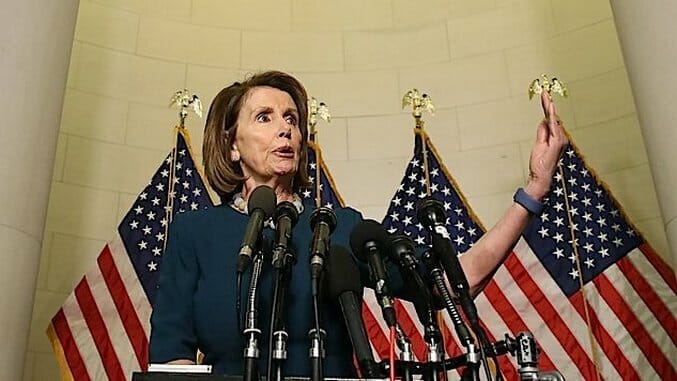“We’re Capitalist” Doesn’t Cut It, Nancy Pelosi
Photo courtesy of Getty
During CNN’s town hall last Tuesday, Nancy Pelosi, the Democratic House Minority Leader, took a question from college student Trevor Hill.
Hill cited a Harvard University poll showing 51 percent of people between the ages of 18 and 29—not just Democrats, not just leftists—no longer support the system of capitalism.”
Pelosi had an immediate, physical, reaction; she recoiled at the mere suggestion capitalism is losing favor among large swaths of the population. Hill continued, noting that, as a gay man, he has been “excited to see Democrats move left on social issues.”
But his question for Pelosi was: Are Democrats open to moving “farther left to a more populist message” on economic issues, creating “a more stark contrast” to right-wing economics?
Pelosi’s response was quick and sure. After all, she couldn’t let anyone get the wrong impression. “Well I thank you for your question,” she said, “but I have to say, we’re capitalist, and that’s just the way it is.”
The House Minority Leader went on to tell a story whose motive was to distinguish between two different capitalisms, one that is good to those at the bottom of income distribution and one that is not. We have entered the age of shareholder capitalism, Pelosi alleged, and that is why CEO pay continues to climb while the average worker sees little to no income growth.
She went on to argue the income inequality we see today is “an immorality,” the “free market” remains “a place that can do good things.”
There’s a reason such talk sounds shallow: For a majority of the population, the so-called “free market” hasn’t worked for a long time. For millennials like Trevor, capitalism appears to have outlived its usefulness; as Fredrik deBoer noted, “only about half of 30-year-old workers in America earn more than their parents did at the same age.”
“Compare that to previous generations,” deBoer added. “In 1940, 92% of Americans in their 30s earned more than their parents did at the same age. That’s a vast drop.”
And, to be sure, it’s not just young people who are feeling the pain of stagnation and decline. As the economists Thomas Piketty, Emmanuel Saez, and Gabriel Zucman noted in a recent report, “For the 117 million U.S. adults in the bottom half of the income distribution, growth has been non-existent for a generation.” It is, they concluded, “a tale of two countries” — one enriched by the current order, one excluded entirely.
There are multiple factors at play here: Tax cuts for the rich, the decline of unions, a slow-growth economy. The financial collapse eliminated the wealth of middle- and low-income homeowners, and many have yet to regain their footing. Wage growth has been largely stagnant since the 1970s.
-

-

-

-

-

-

-

-

-

-

-

-

-

-

-

-

-

-

-

-

-

-

-

-

-

-

-

-

-

-

-

-

-

-

-

-

-

-

-

-








































